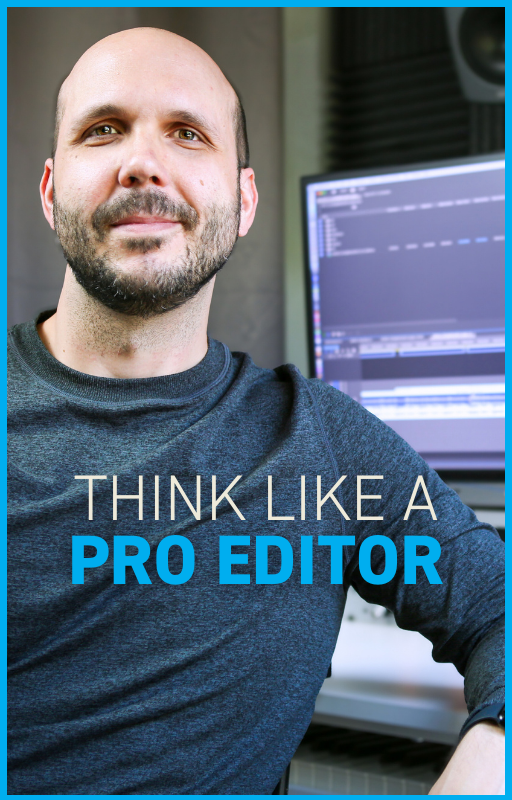How Pro Video Editors Cut Commercials (Breakdown)
Oct 05, 2024How many editing techniques can we learn from a single 30-second commercial?
I’ve been a pro editor for over 20 years and today I’d like to invite you into my edit suite so we can take a look at a commercial I recently completed. Check out the YouTube video above for the full lesson.
Over my career I’ve landed on five editing criteria that I use for every project—emotion, story, rhythm, sound, and action—so we take a look at the spot from these five perspectives. (My editing criteria are adapted from Walter Murch’s six editing criteria from his book In The Blink of an Eye (affiliate link)).
Be sure to read through to the end of the article where I share something about the commercial editing process that you haven’t heard before.
Emotion
I always first ask myself, what emotions am I trying to evoke in the audience? To me, emotion is like the north star of a project. It’s not an editing technique in and of itself, but rather it’s the foundation on which I make all of my other editing decisions.
So when a script lands on my desk, I first consider the overall genre of the piece. This week's video example is a comedy. Sometimes that means you’re going for a big laugh, sometimes a chuckle, and sometimes, just a smile (or in this spot, somewhere between a smile and a small laugh).
So what’s causing the audience to laugh or smile? The concept has a nice juxtaposition of a couple relaxing in the sun and an animated $50 bill doing all the work. So I decided from the outset that highlighting that juxtaposition would be key.
We also have some great physical comedy, which I love, with the bill balancing on a ladder, and then a comedic fall and crash. So my emotional goal for the spot is to elicit a small laugh or smile from the audience and I’m going to accomplish it by playing up the inherent juxtaposition and the physical comedy.
Story
The idea of "story" comes next, and I like to look at story from two perspectives. First, shot to shot, and then overall story structure. While you might not always have all of the elements of a three act structure, we do have some of them here.
The overall story in this spot includes the aforementioned juxtaposition between relaxing and working, along with a complication, climax, and a resolution, all played out in only thirty seconds.
Rhythm
One tip I give to editors is to try and keep their edits on a single track. Then you can actually see the rhythm of your work. Just by looking at the timeline, I can tell whether or not there’s a nice rhythm. For example, in this spot we have two shorter shots corresponding to the climax, which is a nice contrast.
Sometimes I want to make a point with rhythm and I will use a big rhythmic contrast, while other times I want the rhythm to be invisible. Think of a bass player in a band. You might not even notice the steady timekeeping of a great bass player in the mix, but if you took it away the song would fall apart.
Sound
There are a few key things going on with the soundtrack at the beginning of the spot that really help set the tone for the story, such as off-screen sounds. Adding off-screen sounds can make the world seem bigger without having to show more. And subtle, yet very specific, sounds in the background can round out the ambience.
Action
For action, I need to consider the in and out points of each shot. A "match on action" can help smooth out cutting in or out. It’s not always my first choice, but I liked it in this week's spot example.
You may notice in the video that we’ve cut back and forth each time a character speaks. In general, you want to avoid cutting visuals and audio at the same time, but sometimes I think this rhythm can have a nice comedic effect.
I do end up breaking this pattern using a technique called a J-cut (because it looks like a "J" in the timeline). This is also known as a sound-advance cut.
In the commercial world, when you have an extra joke after the art card, it’s called a button.
One quick tip: when you’re cutting comedy, most of the time it works better if you cut it tight, as a tight edit makes the joke punchier.
At the beginning of this article I said I’d give you a little peek behind the curtain of the commercial editing world. One thing I love about working on commercials is that there’s time to experiment and try out many variations. Looking back on this spot I created 34 sequences, each one representing a new idea or variation on how this spot could cut together. More importantly, each of those variations were tested on an audience (usually the director or creative director) and together we landed on the best result.

Austen is an ADDY award-winning film & commercial editor with over 20 years of experience. He has worked with global brands like Meta, KPMG, SAP, and Christianity Today. His PSA work has championed causes like school safety (with Matthew McConaughey), driving safety, and anti-tobacco. A thought leader in the editing field, his online lessons quickly amassed over 100K views after launch.

